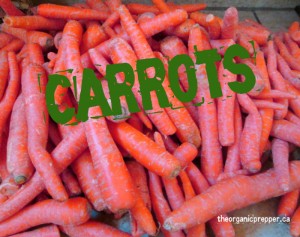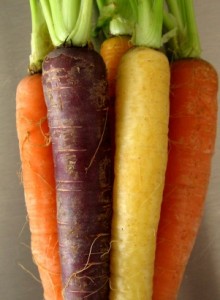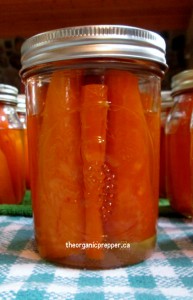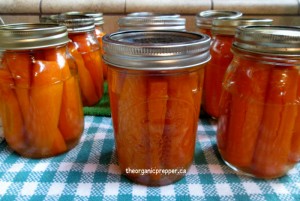
The leaves are beginning to turn, the air is crisp, and the current harvest is root vegetables. This week the focus is on carrots, crisp and sweet, straight from the rich earth. I just scored a 25 pound box of fresh carrots and spent part of a day preserving them – if you don’t have them growing in your own back yard, you can find a local farm or market HERE and get a great deal at this time of year!
Carrot trivia: In ancient times, carrots were actually used for their seeds and foliage as opposed to their taproots. The modern carrot that we enjoy originated over one thousand years ago in Afghanistan. Carrots were mentioned medicinally in ancient Greek and Latin writings. They are typically orange, but there are also heirloom varieties that are purple, red, white, and yellow. Carrots were first documented to be cultivated in North America in 1607. China and Russia produce 2/3 of the world’s carrot supply. Americans only consume an average of 1 cup of carrots per week.

Nutritional benefits
- Carrots are bursting with nutrients.
- A one cup serving of carrots contains about 52 calories, no fat, 12 grams of carbohydrates, and 4 grams of fiber.
- A serving of carrots contains 4 times the minimum RDA of Vitamin A.
- Carrots also contain substantial amounts of B6, thiamine, vitamin C, vitamin K, and vitamin E.
- Carrots contain the minerals sulphur, phosphorus, copper, folic acid, and magnesium.
- Carrots have healing, diuretic, and sedative properties.
- The brighter orange a carrot is, the greater the amount of valuable beta-carotene it contains. Beta carotene is a vital antioxidant phytonutrient.
- Carrots are beneficial to eye health and can help to prevent glaucoma and cataracts.
- Carrots aid in the prevention of colon cancer.
Using fresh carrots
If carrots are organic, peeling is entirely optional – just scrub them well with a brush. If you choose to peel your carrots, store them in a dish of water in the fridge. Carrots should be stored away from ethylene-producing items like potatoes, apples, and pears, as they will cause faster spoilage.
Carrots are excellent raw, cooked, shredded, in a salad, roasted, or pureed into a soup.
A favorite side dish in our household is carrot “fries” which I often serve in place of french fries.
Carrot Fries
Ingredients
- 4 cups of carrots, sliced into coins or sticks
- 3 tbsp of olive oil
- 1 tsp of garlic powder
- 1 tsp of onion powder
- 1 tsp of seasoning salt (no msg)
- 1/2 tsp of cayenne pepper (optional)
Directions
- Preheat the oven to 425 degrees Fahrenheit.
- In a large bowl, mix seasonings into olive oil.
- Stir in carrot slices and toss until they are well coated.
- Spread the carrots on a cookie sheet in a single layer.
- Bake for 20 minutes, then flip the carrots to get them evenly browned.
- Return to the oven for another 10-15 minutes until the carrots are crisp and lightly golden.
- Serve with yogurt ranch dip or barbecue sauce.
Preserving carrots
Freezing: Freezing results in the next best thing to fresh carrots. Peel them if you opt to do so, then blanch the carrots in boiling water for 2-5 minutes, depending on the size you have cut the carrots into. Immediately dunk them into an ice bath for 5 minutes, then freeze them on a cookie sheet. Once they are completely frozen, store them in well-sealed Ziplock bags. Frozen carrots can be roasted, steamed, or boiled.
Dehydrating: To dehydrate carrots, shred them with a coarse grater. Spread them in a thin layer on the tray of your dehydrator and process overnight. Store in an airtight jar in a cool, dark place. Dehydrated carrots can be added to baked goods, soups, stews, and casseroles.
Canning: Canning is not my favorite method of preserving carrots because of the “mushy” texture that results from the pressure canning process. Leaving them in bigger chunks (or even whole) will result in a firmer canned carrot.
Honeyed Carrots

Ingredients
- 10 pounds of carrots
- Raw honey
- Lemon juice
- Sea salt
Directions
- Clean and cut the carrots into your desired size.
- Stuff the sanitized jars full of carrots, making sure you leave a half an inch of headspace at the top of the jar. Add 1/2 tsp of honey, 1 tsp of lemon juice, and a dash of salt (if desired) to each pint jar.
- Fill the jars with hot water, allowing 1/2 inch of headspace.
- Lid the jars and then process them in a pressure canner at 10 pounds for 20 minutes, adjusting for altitude.






























